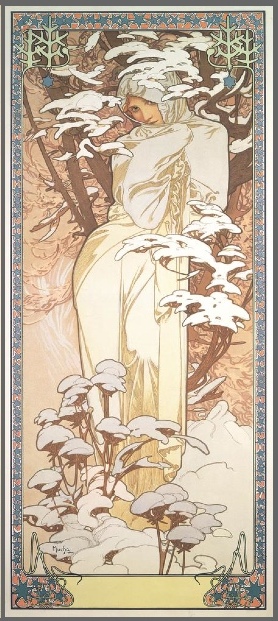Sunday, December 21st, 2014
Alphonse Mucha’s Winter and Christmas Images
Lately I’ve been on an Alphonse Mucha kick, largely because I seem to be spotting books and calendars on Mucha wherever I look. It’s been fun for me to peruse through these items, because I love the flowy, gauzy female figures that appear in his posters and prints. I thought it would be fun to highlight some Mucha images that are appropriate for this holiday, wintery season. I’m especially drawn to his depiction of Winter (shown above) from his 1900 series of The Four Seasons. (Although this image of the series does not seem completely true to Mucha’s original colors, I still like rich tones quite a bit.) Mucha also did other series of The Four Seasons in 1896 and in 1897.
These days, given my recent fascination with Mucha, I’m beginning to familiarize myself with more of his other works of art, as well as his biography. Alphonse Mucha was born in Moravia, an area in Central Europe which was part of the Austro-Hungarian Empire and later Czechoslovakia during Mucha’s lifetime. As an adult, Mucha lived several places in Europe, including Paris. One holiday image that Mucha created while living in Paris is his Noél cover for L’Illustration at the end if 1896 (shown below). In this scene, Mucha depicted two female figures which represent the old year dying and the rise of the new year.
Despite spending most of his life in Europe, one of the things I learned this week about Mucha is that he visited America multiple times between 1904 and 1921; he even lived in America for a few years during that time span.1 Collectively, Mucha spent about ten years of his life in America. In fact, some of the earliest paintings to comprise Mucha’s Slav Epic first debuted in America, in an exhibition in Chicago from June to November of 1920.2

Alphonse Mucha, “Christmas in America,” 1919. Approx. 32″ x 30″ (81.2 cm x 76.8 cm). Private Collection.
One of the paintings that Mucha seems to have made at the start of his seventh (and final) visit to America is Christmas in America (1919, shown above).3 In this painting, a female figure, who is wearing a wreath of evergreen branches, looks out at the viewer. She holds a candle and fruit in her hand, as well as what appear to be either nuts or bells. It has been suggested that this image might be a commentary on the Czech traditions in America. This suggestion makes some sense to me, particularly because the floral patterns on the figure’s sleeves remind me a bit of those found on traditional Czech dresses.
I love Christmas in America because the composition and colors are very calm, straightforward, gentle, and simple. To me, this woman personifies the goodness and peace that embodies the holiday spirit. May your holiday and new year be filled with such goodness, dear reader!
1 For a detailed discussion of Mucha’s time in America, see Anna Daley, “Alphonse Mucha in Gilded Age America, 1904-1921,” Master’s thesis, Smithsonian Institute and Parsons the New School for Design, 2007. Available online: http://www.readbag.com/si-pddr-si-jspui-bitstream-10088-8790-6-annadaleyalphonsemucha
2 Daley, p. 72.
3 Mucha is thought to have arrived in New York in late 1919 or early 1920. I think this painting is a good indication that Mucha had already arrived in America, given the title. See Daley, p. 72.


I also love Mucha because, apart from the beauty of his works, he was Czech. My husband, also Czech, collected everything he could of Mucha’s works. But I had no idea that some of the earliest Epic Slav paintings had their debut in the Chicago Exhibition of 1920.
Since Mucha made his name for designing a poster for the show Gismonda way back in 1894 in France, why was there a delay in seeing his pre-WW1 Slav Epic works until 1920? A bit too risque’?
Thanks for the link
Hels
http://melbourneblogger.blogspot.com.au/2009/01/mucha-proud-czech_19.html
I’ve never known much about Mucha or followed his work. Some of it seems so commercialized now. But these pictures you’ve shared are really gorgeous – the first one seems to have a Japanese style almost, and the second one is very cleverly composed. The painting is also very beautiful and shows a completely different side of his work. Now you’ve got me wanting to see more!
Happy Holidays!
M:
I’d never heard of Mucha so it was a real treat to read this post. Would you call his work art-deco?
Belated Merry Christmas and best wishes for a Happy New Year.
Frank
Hi Frank! Thanks for your comment and Happy New Year! Mucha’s work actually is classified as Art Nouveau, not Art Deco. At a very basic level, Art Nouveau is inspired by more natural forms, whereas Art Deco relies more on geometric forms that are angular and symmetrical. The depictions of plants and flowers in Mucha’s art are one way that his aesthetic fits better with Art Nouveau.
Hels,
Thank you for your comment and the link to your blog post. I loved the posters and images that you included on your site! I didn’t know that Mucha was involved in making jewelry, so I was glad to read that aspect of your own post. Also, you raise some interesting points about the delay in the display of Slav Epic works. I don’t know the answer, but I wonder if the WWI climate somehow prevented Mucha from displaying the works for one reason or another.